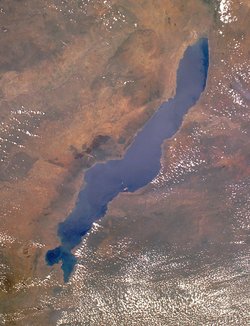Lake Malawi
|
|
Lake Malawi, originally known as Lake Nyasa, Lake Nyassa and Lake Niassa after the Yao word for "lake" (officially, still called Niassa in Mozambique), is the most southerly lake in the Great African Rift Valley system. First "discovered" by the famed Scottish explorer and missionary Dr. David Livingstone, Lake Malawi has sometimes been referred to as "Livingstone's Lake."
| Contents |
Geography
The lake is about 560 km long and 75 km wide at its widest point, with a total area of approximately 29,600 sq km, and is bordered by Mozambique, Malawi, and Tanzania. Its outlet is the Shire River; its largest tributary is the Ruhuhu. About three quarters of the lake is in Malawi; the rest is in Mozambique.
The lake lies in the Great African Rift Valley, a large graben caused by crustal extension. It probably formed about 40,000 years ago.
European discovery and colonization
David Livingstone was the first European to discover the lake, in 1859. Much of the area surrounding the lake was subsequently claimed by the British Empire to form the colony of Nyasaland. Although Portugal colonised the eastern shores of the lake, the islands of Likoma and Chizumulu which lie just off the shore were colonised by Scottish missionaries from Nyasaland, and as a result were incorporated as part of Nyasaland rather than Mozambique.
In 1914, the lake saw a brief naval engagement when a British ship, on hearing that World War I had begun, sank a German ship in Deutsch Ost-Afrika (see History of Tanzania) territorial waters.
Important islands
Lake_Malawi,_view_from_Likoma_Island.jpg
There are two inhabited islands in the lake, Likoma and Chizumulu. Likoma is dominated by a huge stone Anglican cathedral, built by missionaries in the early 20th century. A notable feature of both islands is the large number of Baobab trees. The islands support a population of several thousand people, who grow cassava, bananas and mangos, as well as fishing the waters of the lake.
Lake transport
Large-scale transport between settlements along the shores of the lake and between the Malawi shore and Likoma and Chizumulu islands is provided by steamers. The MV Ilala is the best known, although in recent years has often been out of service. When running, it travels between Monkey Bay at the southern end of the lake to Karonga in the north, and occasionally to Iringa in Tanzania.
Boats travel about twice a week from Nkhata Bay on the mainland to Likoma and Chizumulu islands, taking about five hours to cross the lake. Neither island has a usable port, and boats moor offshore before transferring passengers and produce to the shore in small dinghies.
Informal transport between the two islands, and between Likoma Island and the Mozambique town of Cobue, is provided by small dhow-type boats.
Wildlife
Lake Malawi has traditionally provided a major food source to the residents of Malawi as it is rich in fish, the most famous of which is the Chambo, a fresh-water perch. Lake Malawi also holds a fish group known as the Malawi cichlid. These fish are divided into two basic groups First is the open-swimming, usually carnivorous species, often with colorful males and drab females, are Peacocks or Haps; the latter is short for Haplochromine, though the genus Haplochromis is no longer used for them. Second is a group locally and popularly known as mbuna, which means rockdweller. These fish are smaller, generally vegetarian, and both sexes are quite colorful, though many species are dimorphic. Cichlids are an important export for Malawi, but wild populations are increasingly threatened by commercial collecting and localized pollution. Other wildlife resident in the lake includes abundant crocodiles, and a large population of fish eagles which feed off the fish population.
The lake also supports populations of the snail which spreads bilharzia. For many years this was strenuously denied by the government, which feared it would deter tourism in the area, but since the fall of Hastings Banda, the presence of bilharzia in the lake has been more widely acknowledged.
See also
et:Njassa järv fr:Lac Malawi pl:Jezioro Niasa pt:Niassa (lago) fi:Njassajärvi

